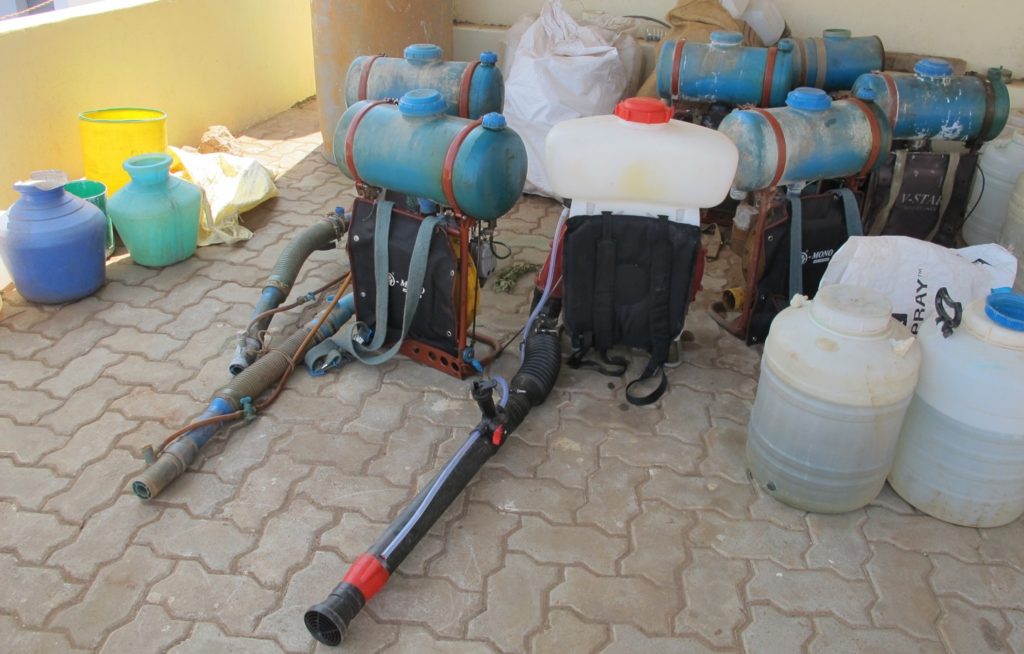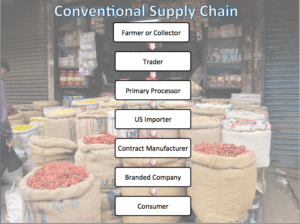Conventional Supply Chain

Herbs on the Open Market
Traders selling herbs on the open market rarely have any information about where or how the plants were grown, how and when they were harvested, and how they were processed, and handled along the way. If there is no accountability, no need to document where the herbs are from or how they’ve been handled, no one seems to care. I’ve seen warehouses filled with piles of dried plants; women sifting dried plants directly on the road next to irrigation channels filled with trash; truckloads overflowing with exposed dried herbs which, especially in India, have likely traveled for miles through some of the most polluted cities in the world. I’ve seen plants arriving at manufacturing facilities in reused cement bags or old plastic bags. I’ve talked with buyers at manufacturing facilities who order shipments of herbs by email, never having visited the traders from whom they are purchasing who, in turn, have never visited the fields or forests from which the plants are sourced.

For spraying pesticides, Tamil Nadu, India.
Traders
The traders sell to manufacturing facilities, again with little oversight of how the herbs are stored, the conditions under which they are transported, etc. I visited Kaoli Baoli, the herb and spice market in Old Delhi, and most of the traders sat at tables next to their phones taking orders. Sacks of herbs were piled against the narrow passage through the center of the market, but not nearly as many as I imagined there would be. These traders now mostly just did transactions, I was told, very little of the trade happened over actual sacks of herbs. As we sat talking to several traders, I felt something nibbling my toe. I jumped in surprise and was told not to worry, that whatever it was wouldn’t hurt me.
 US Importer/Broker
US Importer/Broker
A US (or European, etc.) importer or broker then orders lots of the raw material either from the primary processor or the traders. These brokers in turn sell the raw material to a contract manufacturer who produces the finished product according to specifications from the branded company. But the bigger brokers tend to have customers at different levels. They have customers who require certified material but they also have price buyers. While reputable brokers may prefer not to deal with customers who only care about price, these customers solve the problem of buying up rejected material. They provide a market for plants that come in with no certificate of analysis, don’t pass other certifications, or weren’t tested. The broker takes no responsibility for the quality of the herbs and sells them with no guarantee, leaving it to the buyer to do any tests needed to qualify the material.
Contract Manufacturing
Contract manufacturers will only do what they are required to do from the branded company. If the company doesn’t need certified ingredients or doesn’t specify a particular quality, the contract manufacturer will look for the cheapest product on the market. Because they don’t like to hold too much in stock, contract manufacturers often only buy smaller lots at a time. They rarely have contracts with farmers or with primary processing companies or take the time to develop longterm relationships.
Far more often than consumers imagine, the company whose label we see on the shelf is only responsible for marketing the finished product. Like every step of the supply chain, the quality of the finished product depends on the quality of the relationship between the finished product company and the contract manufacturer and how much each pays attention to what is happening down the supply chain.
In the conventional supply chain, store brands typically trust the contract manufacturer to buy the raw material. The manufacturer may buy from perhaps five different exporters from a number of different countries to spread their risk and be able to buy any particular species at the lowest price. For example, a company might buy ginger from Sri Lanka, China and Indonesia and the quality and composition of the ginger will vary. Because every batch is from a different origin, there will be no batch-to-batch uniformity and no long-term planning.
All of this has a direct impact on issues of quality, sustainability and equity through the supply chain.

Comments